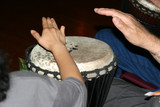Spiritual Significance of the Djembe
When built according to traditional standards, every element of the djembe is rife with spiritual significance. Each piece of the drum holds the spirit of its maker; the wood of the body, the skin of the drum head and the workmanship of the artist who made the drum. By using all three spirits in harmony, the spirits join together to make beautiful, powerful music. The drummer is able to connect with him or herself, to those around, and to nature.
The first of the spirits is from the body's wood. The artist must make an offering to the spirit of the tree before cutting it down to hollow it out. Legend states that the spirit of the tree is a djinn, which is the male, malevolent version of a Genie. Djembes were traditionally carved from hollowed out Dimba trees, the name of which means "Devil Wood." The djinn gave the djembe as a gift to the Malinke people, and many believe that the wood is imbued with the power to make the African people dance.
The second spirit of the djembe is found in the drum head. Goatskin is the preferred animal hide used for djembe drum heads, but artists also use skin from antelopes, deer, camels, zebras and calves. Drum heads are made from the female's hide. Malinke mythology describes the first djembe's drum head as coming from the hybrid of a zebra and a giraffe – a "gebraffe." The drum head allowed the Malike people to communicate over long distances. Therefore, the djembe was an integral element in tribal language, connecting members in other areas.
The instrument maker also lends his or her spirit to the drum. The creation of the djembe was difficult, and was undertaken only by members of the blacksmith caste. In particular, attaching the hide to the wood is difficult, because that attachment is one of the crucial elements in the creation of sound. The artist must take care in the tanning of the hide, because of the reflection of the spirit as well as the resonance of the drum, and in the choosing of the wood, as the wood had to be able to burn all night in a fire. The time and effort used during the artistry of the djembe contributed the spirit of the artist to the djembe.
In Mali, djembes have been used in sacred rituals for more than a millennium. Djembefolas, or djembe players, lead the music for marriages, births and funerals, as well as for a number of seasonal ceremonies. Furthermore, medicine men used the djembe to calm their patients, believing that the djembe could heal the spirit.
In female led groups, frame drums were used for worship of goddesses. Rituals were held at night, connecting the power of the moon and the lunar cycle with menstrual cycles. As a consequence of the relationship between these cycles, women felt closer to the spirit of the feminine divine. The drum is used in depictions of the moon goddess.
Recent Posts
-
X8 Drums Play-Along Backing Tracks
The new X8 Play-Along Series is being produced for our musician friends wanting a fresh way to work …9th Feb 2025 -
What is the Best Size Djembe for Beginners?
If you're new to the world of percussion and interested in learning the djembe, you're in for a t …16th Jul 2024 -
The Benefits of Becoming a Drumming Teacher: Transforming Passion into Profession
Why become a drumming teacher? Becoming a drumming teacher is an excellent way to share your pas …22nd May 2024



